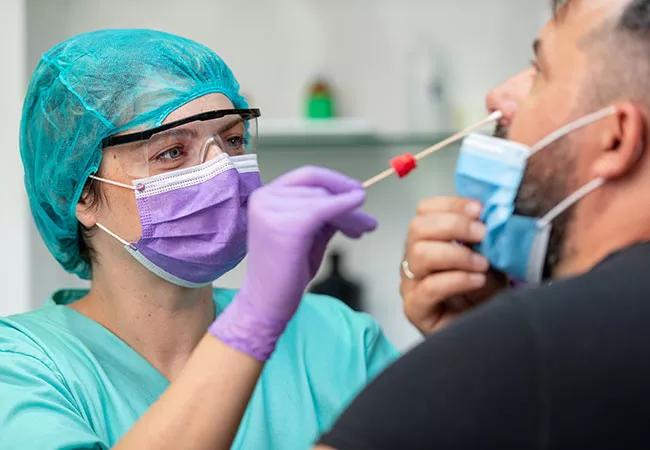The implications of these findings and more

A new Cleveland Clinic-led study examines the distribution of viral load in healthcare providers who tested positive for COVID-19. In the majority of cases, the findings show, the risk of transmission is relatively low after seven to 10 days following the onset of symptoms.
Advertisement
Cleveland Clinic is a non-profit academic medical center. Advertising on our site helps support our mission. We do not endorse non-Cleveland Clinic products or services. Policy
Some individuals who have recovered clinically from COVID-19 continue to test positive for the virus that causes the disease. This testing paradox poses a challenge to many essential workers, who must return to their jobs safely and expeditiously.
Recognizing the challenges associated with test-based strategies, the CDC updated their guidance to include symptom- and time-based criteria to guide back-to-work policy for essential workers. Cleveland Clinic researchers set out to understand the risk of transmission by examining viral load with respect to the time since onset of symptoms in a provider population. The data, they hoped, would guide non-test related protocols for healthcare organizations. The researchers published their findings in Clinical Infectious Diseases.
The risk of transmission is not constant throughout the duration of infection. “The question for us was, ‘How much virus does a person have over the course of the illness? And when do infectious individuals reach a point where the quantity of virus is probably too low for effective transmission?’” says Nabin Shrestha, MD, an infectious disease physician in Cleveland Clinic’s Respiratory Institute and first author of the study.
This study was based on the assumption that the higher the quantity of virus present, the higher the risk of transmission. For the sake of consistency, all specimens were tested using the same reverse-transcription PCR test. Dr. Shrestha explains, “At each cycle during the PCR test, there is a doubling of the nucleic acid target. By knowing at which cycle the target first becomes detectable, known as the threshold cycle (Ct), one can retrospectively estimate the quantity of target originally present in the specimen being tested.”
Advertisement
In the PCR test used, any signal detected after 40 cycles is considered negative, which means that the minimum detectable viral load (MDVL) corresponds to a quantity of virus that would have a Ct of 40. Because each PCR cycle results in a doubling of the amplified target, the quantity of the viral target as a multiple of the MDVL can be determined by the formula: 2^(40 – Ct).
The researchers examined a cohort of infected healthcare providers at Cleveland Clinic during a six-week period, excluding anyone with severe illness that required hospitalization or if the date of symptomatic onset was not documented. Of the 230 subjects that were included in the study, a total of 528 tests were performed. The team made the following observations:
The viral load is higher closer to the onset of symptoms. Tests administered closer to the onset of symptoms had higher viral loads, and tests that were completed further from the symptomatic onset had lower viral loads.
In a multivariable regression analysis, days since onset of symptoms was the only variable associated with viral load. Demographic and clinical variables were not associated with viral load after controlling for days since onset of symptoms.
A significant decline in viral shedding after seven to 10 days. For individuals with non-severe cases of COVID-19, the transmission potential is the highest within the first five days; transmission potential is negligible after seven to 10 days have elapsed since the onset of symptoms.
These findings are consistent with what has been reported in the literature about non-severe cases. However, this study goes a step further by demonstrating quantitative transmission potential over the course of the illness that is based on viral load count, not transmission events.
Advertisement
While calculating the absolute risk of any viral infection at any specific viral load is difficult, these data establish a basis for understanding relative transmission potential over the course of the infection, Dr. Shrestha explains. For Cleveland Clinic, there has been a practical dimension of these data, as it has guided policy about when healthcare workers should return to work.
“Inconsistencies in testing have undeniably posed a challenge in terms of consensus and policy around when it’s safe to return to work. Based on our own data, it’s reasonable to assume that in non-severe cases, an individual’s risk of transmission, based on their viral load, is relatively low after seven to 10 days have passed since the onset of symptoms,” he says. “These data can inform symptom- and time-based strategies to guide a safe return to work.”
Advertisement
Advertisement

Patients report improved sense of smell and taste

Clinicians who are accustomed to uncertainty can do well by patients

Unique skin changes can occur after infection or vaccine

Cleveland Clinic analysis suggests that obtaining care for the virus might reveal a previously undiagnosed condition

As the pandemic evolves, rheumatologists must continue to be mindful of most vulnerable patients

Early results suggest positive outcomes from COVID-19 PrEP treatment

Could the virus have caused the condition or triggered previously undiagnosed disease?

Five categories of cutaneous abnormalities are associated with COVID-19